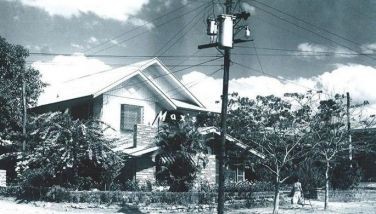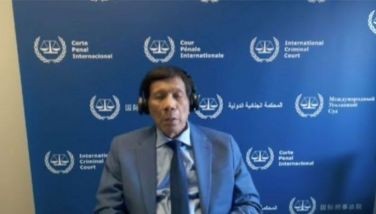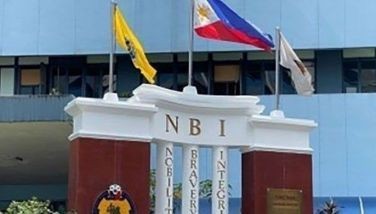Battle of maps

If we’re boxed in, why not think out of the box? This is just a play on words. But this is exactly what our government officials need to do to get us out of the tight grip of Chinese Coast Guard ships around the West Philippine Sea (WPS). The Philippine Coast Guard (PCG) had to pull out from the Escoda or Sabina Shoal their flagship vessel BRP – Barko ng Republika ng Pilipinas – Teresa Magbanua for repair and resupply after five months of patrol mission in that part of the WPS.
Last Sunday, BRP Teresa Magbanua left Escoda Shoal and returned to port due to bad weather, dwindling supplies and the need to evacuate four illness-stricken PCG personnel. As of this writing, the PCG has yet to deploy another vessel to continue patrolling Escoda Shoal, located a few hundred kilometers away from mainland Palawan and within our country’s 200-mile exclusive economic zone (EEZ) at the WPS.
Financially short to buy multimillion-dollar naval and air assets to augment our present fleet, Senate majority leader Francis “Tol” Tolentino suggested to our government policymakers to consider “leasing” naval and warships and planes here and abroad. At the Kapihan sa Manila Bay news forum last Wednesday, Tolentino presented this suggestion, citing the newly amended Government Procurement Law that allows long-term lease arrangements as a mode of acquisition.
Aside from beefing up our presence at the WPS, Tolentino disclosed, two “very important landmark” measures will also help strengthen and support the ruling of the Permanent Court of Arbitration at The Hague that set aside Beijing’s “nine-dash-line” claim that embraced the entire South China Sea (SCS). Tolentino announced the transmittal to Malacañang of the two Congress-approved bills, namely, the proposed Maritime Zone of the Philippines and the Archipelagic Sea Lanes in the Philippines.
As chairman of the Senate special committee on Philippine maritime and admiralty zones, Tolentino is both the author and sponsor of these two measures that they approved in the 19th Congress. Both chambers of Congress separately ratified the bicameral conference committee (bicam) on Philippine Maritime Zone on Aug. 19. Its companion bill on the Archipelagic Sea Lanes was ratified at the Senate last Sept. 4 while the House of Representatives ratified it on Sept. 9.
Tolentino is confident President Ferdinand “Bongbong’ Marcos Jr. (PBBM) recognizes the significance of the twin bills in our WPS claims. The printed enrolled copies of the twin bills are presumably still being vetted for the President’s approval and signing into law.
Data from the Bureau of Fisheries and Aquatic Resources (BFAR) placed at approximately 324,312 metric tons of marine products were procured from the WPS in 2020. According to BFAR, this translates to about seven percent of the total fisheries production of the country for that year.
The two bills delineating the country’s maritime zones and sea lanes were founded on the 1982 United Nations Convention on the Law of the Sea (UNCLOS). Both the Philippines and China are among the country-signatories of UNCLOS. It was the basis of the 2016 Hague Arbitral Ruling that voided Beijing’s “nine-dash-line” claim of the SCS.
Once PBBM signs into law these two bills, the Philippine government – through the Department of Foreign Affairs – will submit them to the International Maritime Organization (IMO) and the International Civil Aviation Organization (ICAO). Tolentino explained the IMO in London and the ICAO in Montreal, Canada will include and update their respective member-nations on these two new domestic laws of the Philippines.
“There will now be a recognition of the name ‘West Philippine Sea.’ For the first time, a law enshrines it,” Tolentino declared.
“This will strengthen international recognition in our favor,” he stressed. “Step by step, we are able to integrate the principles of international law in our own laws, by defining our territorial sea, contiguous zone, exclusive economic zone, sea bed and more,” he further explained.
Whereas before, Tolentino noted, the designation of WPS was implemented by us here through an Executive Order (EO). He was obviously referring to EO 57 that called for ”Strengthening of the Philippine Maritime Security and Maritime Domain Awareness.” Signed by PBBM on March 25 this year, EO 57 renamed and reconstituted the National Coast Watch Council into the National Maritime Council (NMC) chaired by Executive Secretary Lucas Bersamin.
Actually, it was the late president Benigno Simeon Aquino III (PNoy) who first designated the maritime areas on the western side of our country as the West Philippine Sea. “These areas include the Luzon Sea as well as the waters around, within and adjacent to the Kalayaan Island Group and Bajo de Masinloc, also known as Scarborough Shoal.” This was implemented under Administrative Order (AO) No. 29 that PNoy signed on Sept. 5, 2012.
Section 2 of AO 29 stated the naming of the WPS “is without prejudice to the determination of the maritime domain over territories which the Republic of the Philippines has sovereignty and jurisdiction.” Further, AO 29 mandated the National Mapping and Resource Information Authority (NAMRIA) to produce and publish charts and maps of the Philippines reflecting the West Philippine Sea accordingly.
Speaking of maps, Tolentino produced two 18th century maps showing the Philippines done by international cartographers, or mapmakers. According to him, he discovered separately the two maps showing “Islas Filipinas” on his European trips. He found the first map “Malay Archipelago East India Islands” that dated back to 1835 being sold in a “bangketa” (sidewalk) in Belgium which he bought but he refused to say for how much.
Tolentino narrated having “to haggle very hard” with the owner of an archive store in Paris, France for the second map dating back to 1829. After two days of “negotiations,” he agreed to buy from the Carte de Archive the “Carte De L’O Cante et Isles Asiatiques” map which he half-amusingly also refused to say how much he paid in euros.
In the battle of maps, Beijing will only show again their purported 15th century maps as evidence of their “nine-dash-line” historical claims of the SCS.
- Latest
- Trending




























